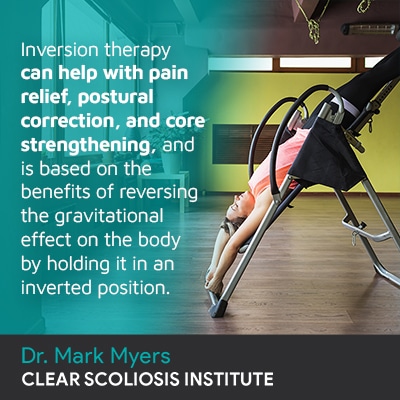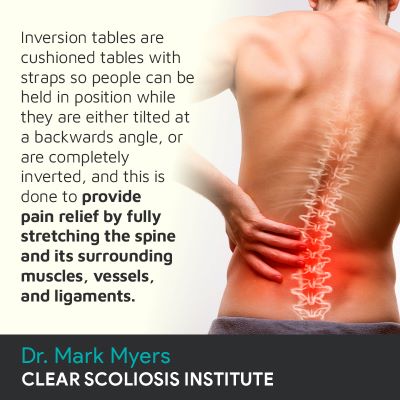
There are only three instances in life where one is not subject to gravity: in the womb, in water, and in space. Inversion tables simulate an anti-gravitational effect by holding the body upside down, opening up the space within the spine, taking pressure off of it, its individual structures, and its surrounding muscles and nerves.
By holding the body upside down, inversion tables can help relieve compression of the spine and its surrounding muscles and nerves, which can have certain therapeutic benefits; however, scoliosis is a structural spinal condition, and inducing a structural change is beyond the scope of inversion therapy.
Before getting to the specific benefits, and limitations, of inversion therapy for scoliosis, let’s first explore what a diagnosis of scoliosis means.
Being diagnosed with scoliosis means a progressive structural spinal condition has developed.
As a progressive condition, the nature of scoliosis is to get worse, and this means scoliosis is increasing in severity over time, the condition’s uneven forces are increasing, as are their effects, and the condition is getting more complex to treat.
So even if a patient is initially diagnosed with mild scoliosis, that doesn’t mean that it won’t become moderate or severe, especially not without the help of proactive treatment that works by counteracting that progressive nature.
Scoliosis involves the development of an unnatural sideways curvature of the spine, and while the spine’s natural curves give it added strength, flexibility, and facilitate its even absorption/distribution of mechanical stress, an unnatural spinal curve can have the reverse effects.
In addition to bending unnaturally to the side, a scoliotic curve also twists, making it a complex 3-dimensional spinal condition.
When a spinal condition is structural, it involves a structural abnormality within the spine itself, and in order to be treated effectively, it has to, first and foremost, be impacted on a structural level.
Scoliosis ranges widely in severity from mild to moderate and severe, and condition severity is determined by a measurement known as Cobb angle, and a patient’s Cobb angle tells me how far out of alignment a scoliotic spine is.
When the spine’s healthy curves are in place, its vertebrae (bones of the spine) are aligned and stacked on top of one another in a neutral alignment, but as an unnatural spinal curve develops, some vertebral bodies are becoming excessively tilted, and this can shift the entire spine out of alignment.
Now that we’ve defined scoliosis, let’s define inversion therapy.

Removing the gravitational effect means reducing compression on the body, the spine, and its surrounding muscles and nerves.
When the spine is growing, prior to reaching skeletal maturity, it’s undergoing a constant lengthening motion, and being inverted allows the spine to fully stretch; this can increase the space within the spine.
The spine consists of vertebrae stacked on top of one another, and adjacent vertebrae are separated by intervertebral discs: spinal structures that are key to its overall health, strength, and function.
When the body is upside down, the spine’s elongation can increase the space between vertebral bodies and the discs in between, and this effect is also felt by the spine’s surrounding muscles, vessels, and nerves.
So what can this relief of pressure help with? Pain from stiffness and compression is one thing, and in addition, it can help increase spinal flexibility, and increase core strength.
The deep stretch that being inverted facilitates can also increase circulation and blood flow, and this not only benefits the entire musculoskeletal system, but is particularly good for the spine’s intervertebral discs that don’t have their own vascular supply.
Relieving pressure on the discs can help improve posture, not that structural scoliosis is caused by poor posture alone, but it can be a contributing factor.
Stretching out the spine and its surrounding muscles can mean a stronger and more-flexible spine, and stronger surrounding muscles for the spine to be supported and stabilized by.
While I can’t deny that a spine that’s surrounded by strong muscles, and one that’s more flexible, is going to be more responsive to treatment, inversion therapy can’t induce the type of structural changes needed to truly address a scoliosis.
In addition, the effects of inversion therapy are only felt while in that position, so are only short term; only proactive treatment can work towards achieving long-term sustainable treatment results and pain relief.
The effects of being inverted can be simulated by performing handstands while leaning up against a wall, gravity boots, inversion chairs, and through the use of inversion tables.

Inversion tables provide a type of spinal traction that works towards taking pressure off the spinal nerves and the discs that sit between adjacent vertebrae, not to mention stretching the spine itself for therapeutic benefits and pain relief.
So what about the use of inversion therapy for scoliosis?
Scoliosis is a structural spinal condition that needs to, as mentioned, be impacted primarily on a structural level to be treated effectively.
In addition, the complex nature of the condition necessitates the full customization of treatment plans, and this involves combining multiple forms of treatment that can be apportioned and adjusted accordingly.
When an inversion table is used for scoliosis, it’s more about pain relief for adult patients, for whom the condition has become compressive; however, it’s important to understand that these therapeutic benefits are not treating the scoliosis itself, so are more indirect than direct.
As a CLEAR-certified scoliosis chiropractor, I follow the CLEAR treatment protocols that involve treating scoliosis proactively by combining condition-specific chiropractic care with a number of therapies so treatment plans can be fully customized.
So if an inversion table is being used for scoliosis, it’s more as a therapeutic tool than a facet of treatment, which relies on chiropractic adjustments that can impact the condition on a structural level by realigning the spine, physical therapy for increasing core strength so the spine is supported by strong muscles, and rehabilitation to further heal and stabilize the spine after treatment.
When it comes to treating scoliosis, there are different approaches and types of treatment to choose from, and as they offer patients different potential outcomes, awareness is important.
When it comes to alternative forms of scoliosis treatment, this has come to mean non-surgical treatment options, and here at the CLEAR Scoliosis Institute, we offer a proactive conservative treatment approach that’s been helping patients avoid the potential risks of spinal surgery for over 20 years.
The benefit of inversion therapy for scoliosis patients is best classified as therapeutic; it’s limited in its ability to impact scoliosis on a structural level, and it’s the underlying structural nature of scoliosis that needs to be impacted the most in treatment.
While the use of an inversion table can help with pain relief, increasing core strength and spinal flexibility, and improving circulation (known to benefit the spine’s intervertebral discs), it can’t impact the condition on a structural level, so should not be regarded as an effective form of scoliosis treatment.
In addition, no patient should be attempting the use of inversion therapy and/or an inversion table without first gaining approval from their scoliosis treatment provider, and ideally, inversion therapy should be performed under the watchful eye of an experienced physical therapist.
Here at CLEAR, we rely on a number of different therapies to augment corrective treatment results achieved through chiropractic care and physical therapy, and while the use of an inversion table does offer certain therapeutic benefits, it’s not generally regarded as an effective tool of treatment for scoliosis reduction.

CLEAR provides a unique and innovative way of understanding scoliosis. Sign up to receive facts and information you won’t find anywhere else.
